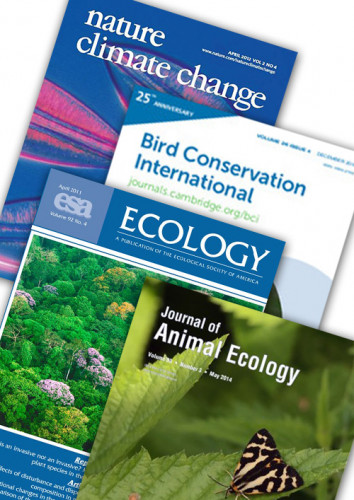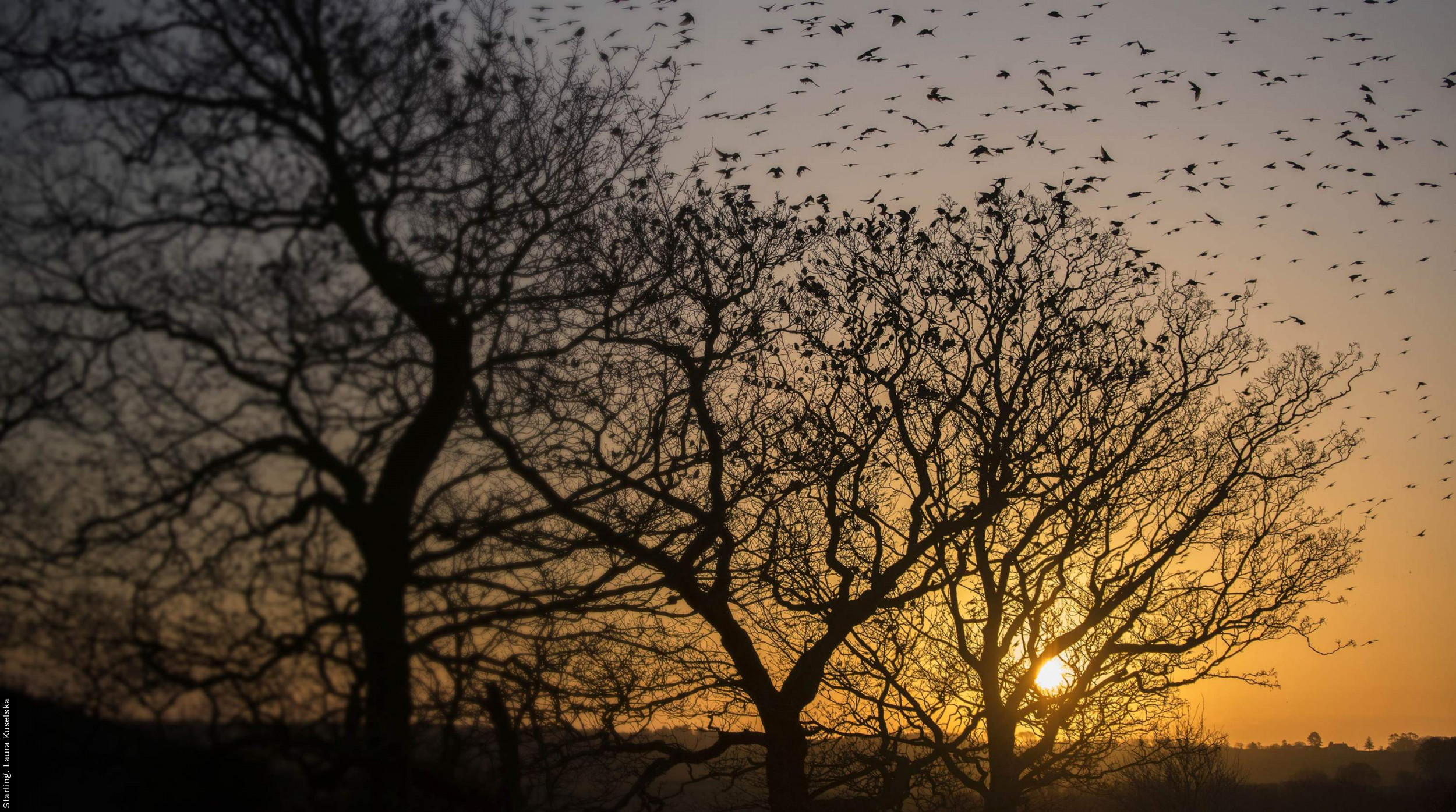Peer-reviewed papers

It is BTO’s policy to make public the results of our research. Our aim is to publish as much as possible of our work in the peer reviewed scientific literature. Many results are also published in our BTO Research Report series.
2009.
Forestry thinning in commercial conifer plantations has little effect on bird species richness and breeding abundance.
Bird Study
56
: 137-141
Link to Article (DOI: 10.1080/00063650802681698)
2009.
Avian productivity in urban landscapes: a review and meta-analysis.
Ibis
151
: 1-18
Link to Article (DOI: 10.1111/j.1474-919X.2008.00899.x)
2009.
Sparrowhawk Accipiter nisus presence and winter bird abundance.
Journal of Ornithology
150
: 247-254
Link to Article (DOI: 10.1007/s10336-008-0344-4)
2009.
Bird use of cultivated fallow 'Lapwing Plots' within English agri-environment schemes.
Bird Study
56
: 289-297
Link to Article (DOI: 10.1080/00063650902792114)
2009.
Does organic farming benefit farmland birds in winter?.
Biology Letters
6
: 82-84
Link to Article (DOI: 10.1098/rsbl.2009.0643)
2009.
Selective mortality of waders during severe weather.
Bird Study
56
: 96-102
Link to Article (DOI: 10.1080/00063650802648465)
2009.
Quantifying the movement patterns of birds from ring recoveries.
Ringing & Migration
24
: 180-188
View Abstract
2009.
What we will do if we catch any Slender-billed Curlews?.
News from the International Waterbird Census, Special Slender-billed Curlew Issue
12
2009.
The use of intrinsic markers to study bird migration.
Ringing & Migration
24
: 169-174
View Abstract
2009.
The status of breeding Woodlarks Lullula arborea in Britain in 2006.
Bird Study
56
: 310-325
Link to Article (DOI: 10.1080/00063650902792163)
2009.
Integrating socio-economics and ecology: a taxonomy of quantitative methods and a review of their use in agro-ecology.
Journal of Applied Ecology
46
: 269-277
Link to Article (DOI: 10.1111/j.1365-2664.2009.01615.x)
2009.
Estimating the annual number of breeding attempts from breeding dates using mixture models.
Ecology Letters
12
: 1 184-1 193
Link to Article (DOI: 10.1111/j.1461-0248.2009.01377.x)
2009.
How climate change might influence the starvation-predation risk trade-off response.
Proceedings of The Royal Society B
276
: 3 553-3 560
Link to Article (DOI: 10.1098/rspb.2009.1000)
2009.
Improving the value of field margins as foraging habitat for farmland birds.
Journal of Applied Ecology
46
: 353-362
Link to Article (DOI: 10.1111/j.1365-2664.2009.01613.x)
2009.
Birds of Conservation Concern III: priority species for conservation action in the United Kingdom, Channel Islands and the Isle of Man.
British Birds
102
: 296-341
2009.
Habitat management and patterns of predation of Northern Lapwings on wet grasslands: the influence of linear habitat structures at different spatial scales.
Biological Conservation
142
: 314-324
Link to Article (DOI: 10.1016/j.biocon.2008.10.027)
2009.
Reversion of arable land to wet grassland for breeding waders.
Conservation Land Management
7
: 5-9
2009.
Latitudinal and seasonal patterns in clutch size of some single-brooded British birds.
Bird Study
56
: 75-85
Link to Article (DOI: 10.1080/00063650802648291)
2009.
Habitat influences on urban avian assemblages.
Ibis
151
: 19-39
Link to Article (DOI: 10.1111/j.1474-919X.2008.00898.x)
2009.
Surrogacy and persistence in reserve selection: landscape prioritization for multiple taxa in Britain.
Journal of Applied Ecology
46
: 82-91
Link to Article (DOI: 10.1111/j.1365-2664.2008.01598.x)
2009.
How many Eurasian Golden Plovers Pluvialis apricaria and Northern Lapwings Vanellus vanellus winter in Great Britain? Results from a large-scale survey in 2006/07.
Wader Study Group Bulletin
116
: 21-28
View Abstract
2009.
Staging behavior in Red Knot Calidris canutus in Delaware Bay: implications for monitoring mass and population size.
Auk
126
: 54-63
Link to Article (DOI: 10.1525/auk.2009.06247)
2009.
Foraging habitat selection, diet and nestling condition in Yellow Wagtails Motacilla flava breeding on arable farmland.
Bird Study
56
: 221-232
Link to Article (DOI: 10.1080/00063650902792080)
2009.
Fine-scale foraging behaviour of a medium-ranging marine predator.
Journal of Animal Ecology
78
: 880-889
Link to Article (DOI: 10.1111/j.1365-2656.2009.01549.x)
2009.
Using repeated winter surveys to estimate changes in abundance of seed-eating passerines.
Bird Study
56
: 65-74
Link to Article (DOI: 10.1080/00063650802648218)
2009.
Raptors. A Field Guide for Surveys and Monitoring. [Superceded by 3rd Edition 2013].
The Stationery Office, Edinburgh
2009.
Effects of crop diversification and low pesticide inputs on bird populations on arable land.
Agriculture, Ecosystems & Environment
129
: 149-156
Link to Article (DOI: 10.1016/j.agee.2008.08.014)
2009.
Population trends of breeding birds in British woodlands over a 32-year period: relationships with food, habitat use and migratory behaviour.
Ibis
151
: 464-486
Link to Article (DOI: 10.1111/j.1474-919X.2009.00937.x)
2009.
Bird species distributions across woodland canopy structure gradients.
Community Ecology
10
: 99-110
Link to Article (DOI: 10.1556/ComEc.10.2009.1.12)
2009.
Densities and population estimates of breeding Eurasian Woodcock Scolopax rusticola in Britain in 2003.
Bird Study
56
: 15-25
Link to Article (DOI: 10.1080/00063650802674768)
2009.
The Barn Owl Monitoring Prgramme: establishing a protocol to assess temporal and spatial variation in productivity at a national scale.
Ardea
47
: 421-428
View Abstract
2009.
Enhanced niche opportunities: can they explain the success of New Zealand's introduced bird species?.
Diversity and Distributions
15
: 41-49
Link to Article (DOI: 10.1111/j.1472-4642.2008.00498.x)
2009.
Population impact of grey squirrels Sciurus carolinensis on woodland bird populations in England.
Journal of Ornithology
151
: 211-218
Link to Article (DOI: 10.1007/s10336-009-0445-8)
2009.
Comparison of habitat-specific trends in the abundance of breeding birds in the UK.
Bird Study
56
: 233-243
Link to Article (DOI: 10.1080/00063650902792098)
2009.
Effects of Horseshoe Crab harvest in Delaware Bay on Red Knots: are harvest restrictions working?.
Bioscience
59
: 153-164
Link to Article (DOI: 10.1525/bio.2009.59.7.21)
2009.
Consequences of organic and non-organic farming practices for field, farm and landscape complexity.
Agriculture, Ecosystems & Environment
129
: 221-227
Link to Article (DOI: 10.1016/j.agee.2008.09.002)
2009.
Urbanisation and time of arrival of common birds at garden feeding stations.
Bird Study
56
: 405-410
Link to Article (DOI: 10.1080/00063650902937313)
2009.
Eye size and the time of arrival of birds at garden feeding stations in winter.
Journal of Ornithology
150
: 903-908
Link to Article (DOI: 10.1007/s10336-009-0412-4)
2009.
A century of ringing in Britain and Ireland. (Editorial).
Ringing & Migration
24
View Abstract
2009.
Declining rates of ring recovery in British birds.
Ringing & Migration
24
: 266-272
View Abstract
2009.
Constant effort: studying avian population processes using standardised ringing.
Ringing & Migration
24
: 199-204
View Abstract
2009.
Critical parameters for predicting population fluctuations of some British passerines.
Journal of Animal Ecology
78
: 1 063-1 075
Link to Article (DOI: 10.1111/j.1365-2656.2009.01565.x)
2009.
Population structure, biometrics and moult of migrant Purple Sandpipers Calidris maritima in southwest Iceland in spring.
Bird Study
56
: 357-368
Link to Article (DOI: 10.1080/00063650902937321)
2009.
Sex-specific food provisioning in a monomorphic seabird, the common guillemot Uria aalge: nest defence, foraging efficiency or parental effort?.
Journal of Avian Biology
40
: 75-84
Link to Article (DOI: 10.1111/j.1600-048X.2008.04507.x)
2009.
Arable field margins managed for biodiversity conservation: a review of food resource provision for farmland birds.
Agriculture, Ecosystems & Environment
133
: 1-3
Link to Article (DOI: 10.1016/j.agee.2009.05.012)
2009.
Habitat associations of British breeding farmland birds.
Bird Study
56
: 43-52
Link to Article (DOI: 10.1080/00063650802648150)



Share this page